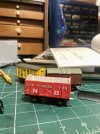Lyndhurstman
Western Thunderer
Hi Jon,I recall reading something about this type of continuous check rail on the late Peter Johnson’s Canada Street (the later layout bearing the name), but I could be wrong?
Jon
Yes... A lot of "inset" trackwork had a finer 'check rail' ( https://bristolharbourrailway.co.uk.../01/95e2c558-1184-4d84-bb8d-69b4ea15a030.jpeg ) whilst some seems to have had none at all ( ). I've gone with the 'heavy stuff' partially to acknowledge the intense building effort that went on across the river at Rotherhithe during the later war years - they prepared the concrete caissons for the Mulberry harbour at Arromanche (Mulberry Harbours at Rotherhithe's South Dock in the Second World War).
Cheers
Jan



 ) It's a wonder of Danny's work, and my hamfistedness. I'll have to revist thise handrails (I've improved my skills in that department, at least!). And it's GNR browness, too. Back in the BR EFG...
) It's a wonder of Danny's work, and my hamfistedness. I'll have to revist thise handrails (I've improved my skills in that department, at least!). And it's GNR browness, too. Back in the BR EFG...



 (I’m horrified to find that was October, 2015; I’m still using Watkins Wharf as a dumping ground/additional shelf space
(I’m horrified to find that was October, 2015; I’m still using Watkins Wharf as a dumping ground/additional shelf space )
)
